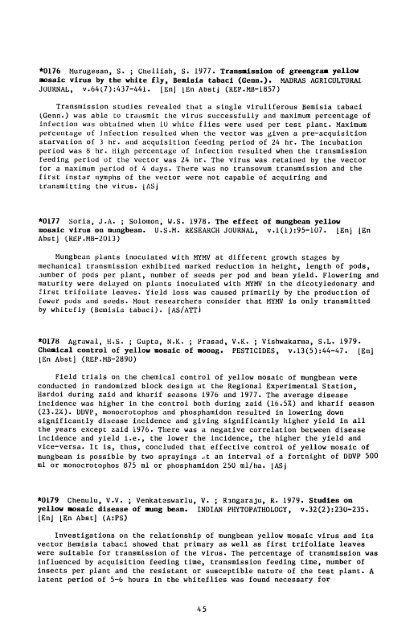PNABD246.pdf
PNABD246.pdf
PNABD246.pdf
Create successful ePaper yourself
Turn your PDF publications into a flip-book with our unique Google optimized e-Paper software.
*0176 Murugesan, S. ; Cnelliah, S. 1977. Transmission of greengram yellow<br />
mosaic virus by the white fly, Bemisia tabaci (Geni.). MADRAS AGRICULTURAL<br />
JOURNAL, v.64(7):437-441. [En] [En Abstj (REP.MB-1857)<br />
Transmission studies revealed that a single viruliferous Bemisia tabaci<br />
(Genn.) was able to transmit the virus successfully and maximum percentage of<br />
infection was obtained when LO white flies were used per test plant. Maximum<br />
percentage of infection resulted when the vector was given a pre-acquisition<br />
starvation of 3 hr. and acquisition feeding period of 24 hr. The incubation<br />
period was 8 hr. High percentage of infection resulted when the transmission<br />
feeding period of the vector was 24 hr. The virus was retained by the vector<br />
for a maximum period of 4 days. There was no transovum transmission and the<br />
first instar nymphs of the vector were not capable of acquiring and<br />
transmitting the virus. [AS]<br />
*0177 Soria, J.A. ; Solomon, W.S. 1978. The effect of mungbean yellow<br />
mosaic virus on mungbean. U.S.M. RESEARCH JOURNAL, v.1(1):95-107. [En] [En<br />
AbstJ (REP.MB-2013)<br />
Mungbean plants inoculated with MYMV at different growth stages by<br />
mechanical transmission exhibited marked reduction in height, length of pods,<br />
Aumber of pods per plant, number of seeds per pod and bean yield. Flowering and<br />
maturity were delayed on plants inoculated with MYMV in the dicotyledonary and<br />
first trifoliate leaves. Yield loss was caused primarily by the production of<br />
fewer pods and seeds. Most researchers consider that MYMV is only transmitted<br />
by whitefly (Bemisia tabaci). [AS/ATTI<br />
*0178 Agrawal, H.S. ; Gupta, N.K. ; Prasad, V.K. ; Vishwakarma, S.L. 1979.<br />
Chemical control of yellow mosaic of moong. PESTICIDES, v.13(5):44-47. [En]<br />
[En Abst] (REP.MB-2890)<br />
Field trials on the chemical control of yellow mosaic of mungbean were<br />
conducted in randomized block design at the Regional Experimental Station,<br />
Hardoi during zaid and kharif seasons 1976 and 1977. The average disease<br />
incidence was higher in the control both during zaid (16.5%) and kharif season<br />
(23.2%). DDVP, monocrotophos and phosphamidon resulted in lowering down<br />
significantly disease incidence and giving significantly higher yield in all<br />
the years except zaid 1976. There was a negative correlation between disease<br />
incidence and yield i.e., the lower the incidence, the higher the yield and<br />
vice-versa. It is, thus, concluded that effective control of yellow mosaic of<br />
mungbean is possible by two sprayings ,t an interval of a fortnight of DDVP 500<br />
ml or monocrotophos 875 ml or phosphamidon 250 ml/ha. [AS]<br />
*0179 Chenulu, V.V. ; Venkateswarlu, V. ; R3ngaraju, R. 1979. Studies on<br />
yellow mosaic disease of mung bean. INDIAN PHYTOPATHOLOGY, v.32(2):230-235.<br />
[En] [En Abst] (A:PS)<br />
Investigations on the relationship of mungbean yellow mosaic virus and its<br />
vector Bemisia tabaci showed that primary as well as first trifoliate leaves<br />
were suitable for transmission of the virus. The percentage of transmission was<br />
influenced by acquisition feeding time, transmission feeding time, number of<br />
insects per plant and the resistant or susceptible nature of the test plant. A<br />
latent period of 5-6 hours in the whiteflies was found necessary for<br />
45

















